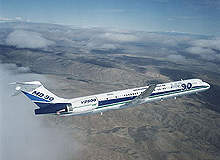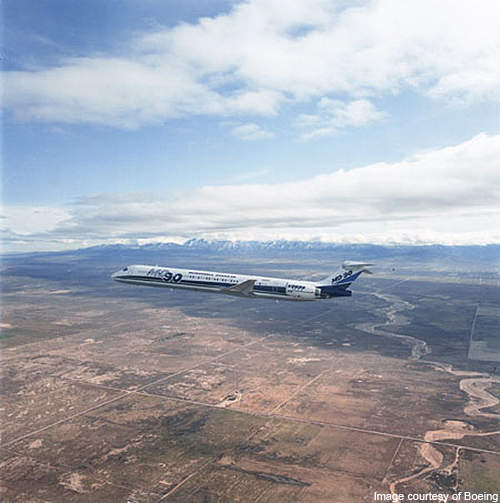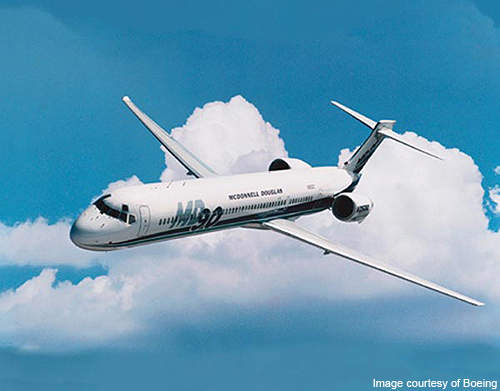The McDonnell Douglas MD-90 is a dual engine, medium-range commercial aircraft. A single aisle aircraft, the MD-90 was developed from the MD-80 series which in turn was based on DC-9 aircraft. The first flight of MD-90 was completed in February 1993 and the aircraft entered into service in 1995. The jet achieved its FAA certification in 1994.
Boeing and McDonnell Douglas merged in 1997. The production of MD-90 took place adjacent to the Long Beach Airport of California, while two aircraft MD-90-30 Trunkliner’s were built at Jiangwan Airfield in Shanghai, China. The production was phased out in 2000 after delivery of the last aircraft to Saudi Arabian airlines.
The MD-90 was produced in two versions, -30 and -30ER. A longer range version, -50 was also offered but was never ordered. Following the MD-90 in the DC-9 family was the MD-95 which was renamed as the Boeing 717-200 after the merger.
Variants
The main variant is the MD-90-30 with two V2500 engines and an EFIS cockpit.
The MD-90-30IGW variant is an added Gross Weight version with only one built.
The MD-90-30ER is an extended range version of MD-90-30 with only two built.
The MD-90-30T "Trunkliner" variant was assembled by Shanghai Aviation Industrial Corporation in China.
Production was initially planned for 40 of these but was later cut down to 20, and only two built in the end.
This variant can accommodate heavy aircraft on unsuitable runways with a dual tandem landing gear featuring more tires to spread the weight of the aircraft but ultimately this feature was not used in the two Trunkliners produced.
Orders and deliveries
Delta Air Lines ordered 50 MD-90s, with an option of 110 more aircraft, in November 1989.
A total of 116 aircraft were ordered and delivered from the aircraft’s maiden flight through to 2000. The first delivery was to Delta airlines in February 1995. The last delivery was in October 2000 to Saudi Arabian Airlines.
The launch customer was Delta which had 31 on firm order, while other major customers included Saudi Arabian Airlines and Japan Air Systems.
By August 2009, a total of 109 MD-90 aircraft were in service. Airlines the flew with included Saudi Arabian Airlines (29), Delta Air Lines (28), Japan Airlines (16), China Southern (13), Uni Air (5), EVA Airways (6), Blue1 (5), Hello Airlines (3) and Lion Air (5).
The Shanghai Aviation Industrial Group of China (SAIC) was the main Chinese contractor for the MD-90 co-production program with MDC and with Boeing after the merger. Chinese participation in the programme involved three Chinese companies producing sub-assemblies.
They were Xian Aircraft for wing and fuselage sections, Chengdu Aircraft for nose sections and Shenyang Aircraft for empennage and electrical-power systems.
Design and features
The MD-90 holds five interior space arrangements. It offers a higher degree of comfort and low interior noise levels to passengers. The aircraft can accommodate 153 to 172 passengers in its large cabin.
MD-90 is an upgraded version of MD-88 aircraft. Both are equipped with an electronic flight instrument system (EFIS) and powerful, fuel effective IAE V2500 engines. The initial MD-90 featured a glass cockpit similar to that of the MD-88.
The MD-90 features an enhanced interior design, vacuity bathrooms, and improved electrical and auxiliary power systems. Other features include an upgraded digital environmental control system, lighter weight carbon brakes with a digital anti-skid system and major improvements to the aircraft’s hydraulics.
The aircraft has 1.4m fuselage forward stretch of the wing, which extends the seating capacity to accommodate ten more passengers. The stretch forward of the wing also balances the extra weight of the engines. The MD-90 also contains an EFIS glass flight deck and an improved passenger interior.
Flight deck
The aircraft has an advanced flight deck which comprises a flight management system (FMS), an inertial reference system and LED dot-matrix exhibit for system and engine supervising. The flight deck consists of a thrust rating panel, which allows the pilots to select from 25,000 pounds of thrust to 28,000 pounds of thrust depending on the conditions of each flight. The changed thrust choices of less than 25,000 pounds are also accessible. The thrust rating panel makes flight more economical and provides high power for high height airports.
Avionics
The MD-90s delivered to Saudi Arabian Airlines carried a glass cockpit with avionics and an overhead display panel for easy transition for the pilots.
Landing gear
The Chinese built Trunkliners featured a double bogey main landing gear.
Engines
The MD-90 is powered by fuel-efficient International Aero Engine (IAE) V2500 engines, which boast reduced emission levels.
The engine’s design reduced the noise levels, making it one of the quietest aircraft ever built in its class at that time.
Performance
The -30 has a range of 3,860km. The -30ER has a range of up to 4,426km with an auxiliary fuel tank.
The MD-90-30 has a takeoff gross weight of 156,000 lbs and can carry 155 passengers. The MD-90-30ER has maximum gross weight of 166,000 pounds. It has a take-off thrust of 25,000 pounds. It also comes with a 28,000 lbs take-off thrust rating, which is optional for operators in requirement of special take-off performance.






